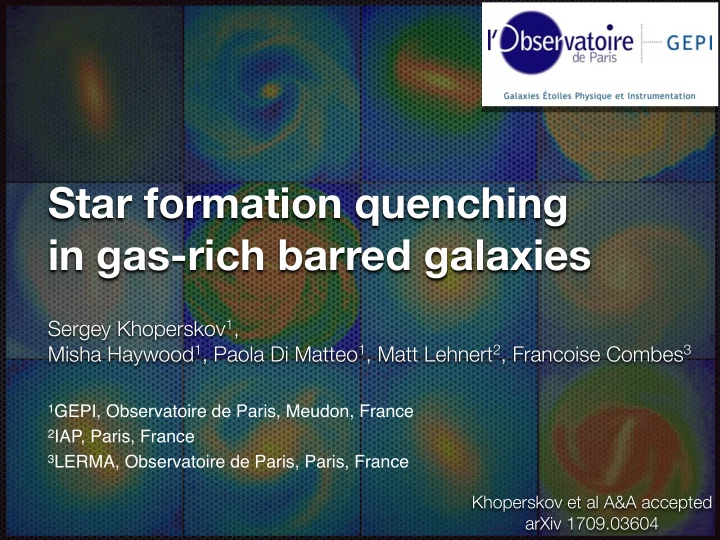

Star formation quenching in gas-rich barred galaxies Sergey Khoperskov 1 , Misha Haywood 1 , Paola Di Matteo 1 , Matt Lehnert 2 , Francoise Combes 3 1 GEPI, Observatoire de Paris, Meudon, France 2 IAP, Paris, France 3 LERMA, Observatoire de Paris, Paris, France Khoperskov et al A&A accepted arXiv 1709.03604
The color-magnitude diagram Hogg et al. 2003
The color-magnitude diagram Galaxy color bimodality Hogg et al. 2003
The color-magnitude diagram Galaxy color bimodality Hogg et al. 2003 Blue cloud: star-forming, a lot of gas, spiral
The color-magnitude diagram Galaxy color bimodality Hogg et al. 2003 Red sequence: non-star-forming, little gas Blue cloud: star-forming, a lot of gas, spiral
Evolution of galaxies Color Magnitude
Evolution of galaxies Color Secular evolution Gas consumption Magnitude
Evolution of galaxies Gas accretion Color Secular evolution Gas consumption Magnitude
Evolution of galaxies Gas accretion Color Quenching Secular evolution Gas consumption Magnitude
Evolution of galaxies Gas accretion Color Quenching Secular evolution Gas consumption Magnitude
Evolution of galaxies Gas accretion Color Quenching remove gas Secular evolution inefficient SF Gas consumption Magnitude
Nearby quenching
Nearby quenching
Nearby quenching Thick disk formation CEM by Snaith et al 2015
Milky Way: ”quenching” Haywood+ 2016 continuity in chemical evolution Rapid decrease of SFR After quenching: gas-rich disk Snaith+ 2015
Nearby galaxies morphology
Nearby galaxies morphology z~0: 60-70% of galaxies have a bar
Nearby galaxies morphology z~0: 60-70% of galaxies have a bar N-body sims -> bar is a long-lived structure
CALIFA barred galaxies MW “Quenching” González Delgado+ 2017
Most of disk galaxies quenched SF in the past
Most of disk galaxies quenched SF in the past A lot of galaxies are barred now
Most of disk Typically bar galaxies is a long-lived quenched SF structure in the past A lot of galaxies are barred now
N-body/hydro simulations Isolated disk galaxies • Gaseous disk (30 pc resolution) • Radiative heating/cooling • Star formation • Initial thick stellar disk • New born particles (0.5-4 10 6 particles) • Stellar feedback (SNe, stellar evolution STARBURST’99) • Dark matter halo (rigid or 0.5-1 10 7 particles) • Models of gas rich galaxies (initially M gas /M stars ~ 0.5-1)
Unbarred galaxy. Star formation rate Gas fraction f=1
Unbarred galaxy. Star formation rate Gas fraction f=1
Unbarred galaxy. Star formation rate Gas fraction f=1 Different radii total
Barred galaxy. Star formation rate Gas fraction f=1
Barred galaxy. Star formation rate Gas fraction f=1
Barred galaxy. Star formation rate Gas fraction f=1 Different radii total
Star formation efficiency Different radii Unbarred galaxy Barred galaxy SFE = SFR / Gas density
Gas velocity dispersion Different radii Unbarred galaxy Barred galaxy bar formation time scale
Gas velocity dispersion
Bar Gas velocity dispersion rotation
Bar Gas velocity dispersion rotation Gas (supersonic) flow
Bar Gas velocity dispersion rotation Gas (supersonic) flow
Bar Gas velocity dispersion rotation Shock wave(!) Gas (supersonic) flow
Bar Gas velocity dispersion rotation Shock wave(!) dust lines Gas (supersonic) flow
Bar Gas velocity dispersion rotation Shock wave(!) Gas (supersonic) flow
Bar Gas velocity dispersion rotation Shock wave(!) Gas (supersonic) flow
Gas (partially) lose Bar Gas velocity dispersion angular momentum rotation stellar density Shock wave(!) gas LOS velocity Gas (supersonic) flow
Bar Gas velocity dispersion rotation Shock Velocity wave(!) gradient Gas (supersonic) flow
Bar Gas velocity dispersion rotation Shock Velocity wave(!) gradient Gas (supersonic) flow
Kelvin-Helmholtz- Bar Gas velocity dispersion rotation type instability Shock Velocity wave(!) gradient High gas velocity dispersion Gas (supersonic) flow
Gas density SFR SFE
Kennicutt-Schmidt relation. Gas-rich galaxy Before the bar formation Whole disk Gas surface density
Kennicutt-Schmidt relation. Gas-rich galaxy After the bar formation Whole disk Gas surface density
Kennicutt-Schmidt relation. Gas-rich galaxy After the bar formation Whole disk Gas surface density Flattening of the KS relation in the central regions
Kennicutt-Schmidt relation Gas-rich galaxy <5 kpc 5<r<10 kpc Whole disk A prediction to be checked with observations of high-redshift, or local gas-rich galaxies.
Conclusions • Bar -> turbulent motions • Within the bar size gas vel. dispersion + 10 − 25 km s − 1 • SFE (in highly turbulent gas) is less efficient • Factor of 5-10 in comparison to unbarred • For 10% bar amplitude and M_gas/M_stars ~ 1.0: SFR suppressed by a factor of 10 during 1 Gyr • agreement with Milky Way star formation quenching episode more details on arXiv 1709.03604
Recommend
More recommend